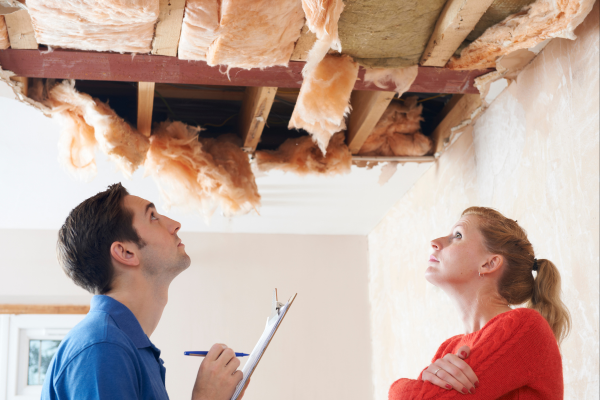Water damage is any unwanted intrusion of water that may be in an area within your home, usually depicted by material deterioration, structural damage, or mold growth. The most common causes of this kind of damage in homes are leaking pipes, roof damage, flooding, and plumbing malfunctions. Whether it is a slow drip or a sudden burst, water can wreak havoc on your property if left unattended. The purpose of this blog is to let you know the signs of water damage in your home.
Water damage detection at an early stage is important to avoid expensive repairs and structural integrity at home. When these early signs are disregarded, they may turn into mold growth, weakened foundations, or damaged electrical systems. Most homeowners tend to ignore minute signs of water damage until major issues pop up; therefore, being informed about the early signs is crucial.
Visible Stains and Discoloration: A Common Evidence of Water Damage in Home
Probably, one of the most evident marks of water damage in home interior comes out as visible stains or some sort of discoloration. Often, these stains appear as brown, yellow, or copper-colored spots on the ceilings, walls, or floors, showing that moisture has seeped through. Where to Look for Stains and Discoloration
Common areas that could develop water stains include but are not limited to underneath the sinks, around window areas, around bathtubs, and along the rooflines. Places like these are really prone to water accumulation due to certain leakage or improper sealing.
Why Stains and Discoloration Occur
The main culprits behind these stains are leaky pipes, roof leaks, or accumulated moisture over time. The water that seeps through the surface materials leaves mineral deposits behind, which cause visible discoloration. Many of these stains, if left unresolved, can worsen to become symptoms of a more serious underlying problem, such as rot or structural damage.
It pays to take notice of early signs now rather than later in the home, whether it be on ceilings or in walls, when water damage signs can become far more significant.
Mold and Mildew Growth: Key Signs of Water Damage in Home
Excess moisture in homes leads to the growth of mold and mildew-one of the scariest signs of water damage. Most molds appear as dark green, black, or grayish spots. It also brings to light that the water damage now puts the house dwellers into serious health trouble.
Health Effects of Mold Growth
Exposure to molds has a range of potential health effects that include from an average-level nuisance issue related to allergic reactions or the worsening of asthma to severe diseases. The people who are immunocompromised and with previous respiratory conditions might experience serious health consequences of mold growth, including shortness of breath and even consistent coughing. In addition to being an eyesore, visible mold in your house is evidence that water damage has occurred in your home, which can affect the health of your family.
Where Mold and Mildew Appear in the House
Mold and mildew attach themselves to wet and dark areas where water has gathered over some period. The basement, bathrooms, or beneath the floor and behind the wall prove to be good sites for these organisms to grow. If you begin to see these dark spots, this is usually a sure sign that there is water damage in your home, which should be repaired straight away before it spreads and causes structural problems.
Musty Smell: Signs of Water Damage in Home
Among other major telltale signs of water damage in a house, a lingering musty smell or dampness might be yet another sign. Often, when apparent signs like stains or mold have not appeared, a rank musty smell is a sure indicator of a hidden moisture problem. This musty smell generally comes from water that has been rendered stagnant, finding its way through building materials like wood or drywall.
What Causes the Smell of Mustiness
The smell becomes musty due to water absorbed by materials over time, acting like a substratum to provide a living space for mold and bacteria. While the water continues to seep into the walls, ceilings, and floors, it becomes trapped and stale, hence giving this unpleasant smell that seems never to go away even after the water has dried up.
Common Places Where Musty Odors Characteristically Occur
The typical sources of this musty odor are crawl spaces, basements, and attics, where ventilation is poor and moisture can easily build up. If you smell a musty scent in these places, that surely means water damage might already be there, even if you don’t see it yet. This hint of water damage in home areas will lead to a situation with much greater destruction if left unchecked and thus requires early intervention.
Peeling or bubbling paint/wallpaper is a common sign of water damage in home. The peeling and bubbling paint or wallpaper are probably the most visible signs of water damage inside the house. If water was collecting behind surfaces, adhesives or materials used might be weakened or degraded by it, ultimately deteriorating the paint or wallpaper.
Signs to Look Out For: Signs of Water Damage in Home
Look for blisters, bubbles, or cracks in paint or wallpaper. These are clear indications that there is water behind the surface-the water slowly deteriorating the material. Other key signs of water damage to watch out for include peeling edges or areas where paint seems to curl off the wall.
Why It Matters
Apart from peeling or bubbling surfaces that affect the look of your house, a lot of them reveal underlying leaks behind walls and ceilings. These, if left unattended, further deteriorate by developing mold or causing structural issues. Early signs of water damage in home environments can save owners from further deterioration and costly repairs.
Warped or Swollen Walls, Floors, and Ceilings: Major Evidence of Water Damage in Home
Sometimes, water damage does not have to stay invisible; at times, it causes noticeable change in the physical structure of a home. Warped or swollen walls, floors, and ceilings are major signs of water damage that might show themselves in areas of your home because of too much exposure to moisture.
Where to Check for Warping or Swelling
You should check around the doors and windows and around the areas with plumbing fixtures such as bathrooms or the kitchen. In particular, the swelling of woods or drywall or, the bumps implies the intake of water over some time. Buckled flooring, drooping ceilings, or warped door frames will hint that water has deeply seeped into the material.
Causes of Warped or Swollen Surfaces
Surfaces also become warped primarily due to moisture from leaks or flooding over an extended time. This may be because of a leaky roof, burst pipe, or long-term water intrusion, where the material absorbs moisture and deforms. Often, this requires big repairs or replacement.
Higher Utility Bills: Signs of Water Damage in Home
When you suddenly find an unexpected surge in your water bill for no apparent coverage of increased use, this could be a silent indication of water damage in home systems. It is very probable that hidden leaks or water wastage may be one of the standard causes for an increased rise in water costs.
What to Look For
Be on the lookout for a spike in the water bills every month. If the bill is higher, and you know you have not used more than usual, then it is time to find those sneaky hidden leaks in your plumbing system. Sometimes, these little leaks pass with no notice but can be a huge waste of water over some time.
The Most Common Sources of Increased Water Bills
The most common sources of water wastage are leaky pipes, faulty plumbing, or undetected leaks behind walls and under floors. Even small, slow drips will add up, causing both increased utility costs and water damage. Early identification and fixation of the problem can save you money by preventing extensive damages to the structure of your home.
Soft spots or spongy spots on walls and on the floors are among those hidden water damages in a home.
Spongy or soft spots in the walls or floors have to be one of the more subtle and yet overt signs of water damage in home structures. These will not feel quite as solid and can easily go unnoticed until they’re pressed or walked on.
Where to Check for Soft or Spongy Pockets
You should feel for soft spots in bathrooms, basements, kitchens, or areas around water appliances such as dishwashers and washing machines. This is because such areas are highly susceptible to water leaks or accumulation of moisture. In fact, all it takes is a press on a drywall or even a wood flooring to reveal the spongy texture that makes up the composition when there is water damage in these places.
Why It’s Worrisome
Excess moisture makes the drywall or wood flooring considerably weak, causing these surfaces to break down over time and compromise structural integrity. If damage like this isn’t tended to as fast as possible, it can lead to some seriously heavy repairs-even replacing walls and floors. The presence of these soft spots in a home sure indicates water damage within and this should be attended to right away to prevent more problems from occurring.
Sounds of Running Water: Signs of Water Damage in Home
The chirping sound of running, trickling, and/or dripping water, when no taps or home appliances are in use, is another warning signal of possible water damage in a home environment. Many a time, these types of sounds are really indicative of concealed leaks behind your walls, under your floors, or inside your home’s plumbing system.
Common Reasons for Mysterious Water Noises
These may be due to minute leaks in your plumbing, some cracked pipes, or water trapped inside the hidden areas of walls and ceilings. Though you may not see the water, hearing it is a serious indicator that something is not right.
Why It’s a Red Flag
You would know that there is water damage if you can hear running water after everything is turned off-it’s an indication of immediate attention at home. This can indicate a hidden leak, which, if left unchecked, may lead to massive structural damage and possibly even mold growth. You get to save yourself from expensive repairs later on.
The sooner you address these early signs of water damage in your house, the better you will be at preventing further damage later on. Occasional inspections followed by immediate attention to indicative signs like peeling paint and/or odd sounds of water help you avoid expensive repairs. If you’ve come across any of these warning signs mentioned here, do take immediate action. Isn’t it time to nip this problem in the bud? Contact Tri-State Ready Restoration today for professional water damage restoration and keep your home safe from all hazards.

